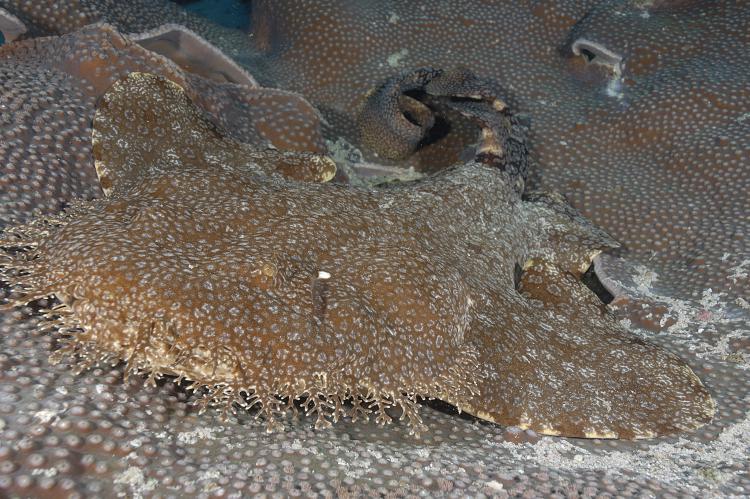Wobbegongs of Raja Ampat
Beautifully adapted to an ambush predator existence, wobbegongs rely on their exquisitely cryptic coloration to avoid detection and catch their prey by surprise.
Wobbegongs—also commonly known as carpet sharks due to their velvety and highly ornamented livery—are currently grouped into three genera and eleven species. All are found in the Western Indo-Pacific, mostly in shallow Australian and Indonesian waters. Their common name derives from the Australian aboriginal language meaning “shaggy beard”, referring to the flaps and tassels growing around their wide mouths.
The specimens featured in these pages were all photographed during several separate dives in the Raja Ampat area (an archipelago of four large islands and several islets located in front of the Vogelskop Peninsula) and are easily identified as tasselled wobbegongs, Eucrossorhinos dasypogon, a species frequently observed in West Papuan waters where it reaches a maximum size of 1.3 meters. The largest species of carpet shark, the spotted wobbegong, Orectolobus maculatus, is found in Western Australia and grows up to an imposing 3.2 meters.
Only one—clearly identified in the caption of the image—is a very rare and apparently still undescribed species which we photographed in Bali. Most carpet sharks are rather small, but in fact they belong to the same order—the Orectolobiformes—of the whale shark, Rynchodon typus, the biggest living fish in the world.
The wobbegong's muscular body is wide and flat, finely patterned in yellowish and pale blue spots, with bands and rosettes neatly arranged on a tan background. Wobbegongs are a true wonder of nature to behold, as they lie immobile in ambush on large table corals—a far cry from the popular image of the shark as a torpedo-like, steel-grey, sleek predator patrolling the blue void of the open ocean.
Their incredibly wide, highly compressed head and mouth profile is broken by an array of dermal flaps and tassels. Their small, beady and slightly malevolent eyes are cleverly hidden in a confusing maze of reticulations. Their broad, paddle-like pectoral fins are widely spread out, and their dark, ribbon-like tails are curved at a sharp angle...
(...)
Download the full article ⬇︎

Originally published
X-Ray Mag #54
Diving Cocos Island; British Columbia's Southern Gulf Islands; Seals of Farne Islands; The Lermontov Wreck off New Zealand; Japan's Yonaguni Jima; Finland's Ojamo Mine; Expedition to the Maldives; Dive Fitness Programs for Divers; Scuba Instructor Training; Tech: Self-Sufficiency vs Team Diving; Macro with Mirrorless Cameras; Peter Hughes Profile; Frozen Water: Amanda Brisbane's Sand Cast Glass; Plus news and discoveries, equipment and training news, books and media, underwater photo and video equipment, turtle news, shark tales, whale tales and much more...































